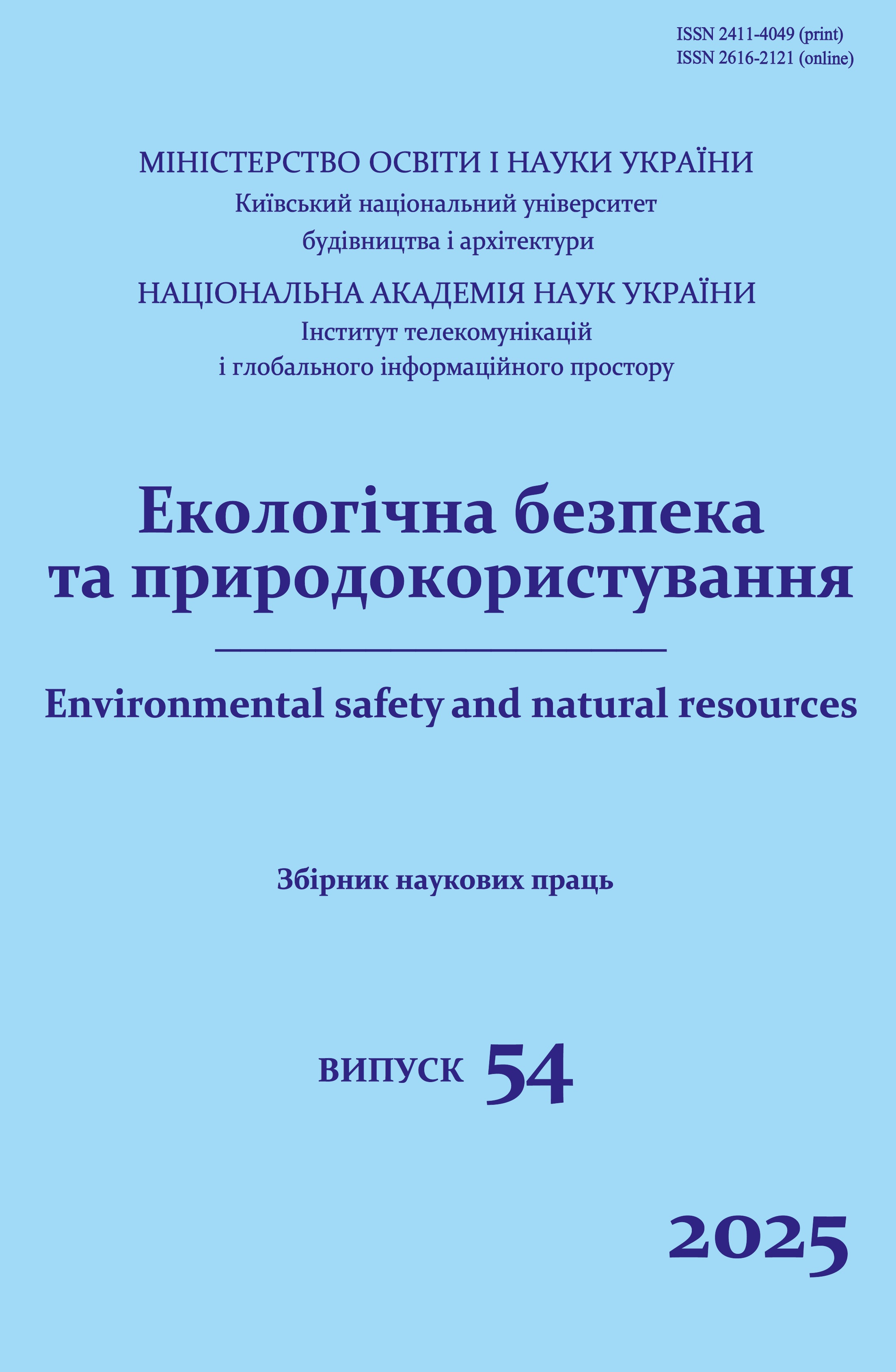Sick building syndrome: uncertainty of causes and challenges of classification
DOI:
https://doi.org/10.32347/2411-4049.2025.2.74-83Keywords:
Sick Building Syndrome (SBS), video ecology, classification of SBS risk factors, natural biotechnical filtersAbstract
The article addresses the problem of developing a universal classification of negative factors associated with Sick Building Syndrome (SBS), taking into account current technological, climatic, and epidemiological challenges. A critical analysis of existing approaches is provided, including classifications proposed by the WHO, CPSC, and various researchers who identify physical, chemical, biological, psychophysiological, and other groups of pollutants. It is shown that none of the existing systems fully cover the entire spectrum of external and internal factors – particularly neglecting climate influences, epidemiological threats, socio-psychological conditions, and new “video-ecological” parameters related to visual homogeneity and aggressiveness of the built environment.
Based on an interdisciplinary approach, an extended classification is proposed, dividing SBS factors into two broad groups: external (climatic, ecological, radiological, video-ecological) and internal (microclimate parameters, physical, technical, radiological, psychological, and biochemical factors). Special attention is given to video ecology – a field that examines the impact of homogeneous and aggressive visual environments on the oculomotor system and the psycho-emotional state of individuals.
The role of natural biotechnical filters – indoor plants – is also considered. These plants regulate humidity, absorb VOCs and CO2, emit phytoncides, suppress pathogens, reduce noise, and enhance psycho-emotional well-being. Recommendations are provided for integrating plants into biophilic design as a cost-effective means of improving indoor environmental quality and preventing SBS.
The proposed classification aims to improve risk assessment, the development of preventive measures, and building operation standards to safeguard the health of residents and workers in the context of urbanization, energy efficiency, and global climate change.
References
Ravindra, K., Kaur-Sidhu, M., Mor, S., Chakma, J., & Pillarisetti, A. (2021). Impact of the COVID-19 pandemic on clean fuel programmes in India and ensuring sustainability for household energy needs. Environmental International, 147, 106335. https://doi.org/10.1016/j.envint.2020.106335
National Human Activity Pattern Survey. The national human activity pattern survey (NHAPS): a resource for assessing exposure to environmental pollutants. (2001). Journal of Exposure Science and Environmental Epidemiology, 11, 231–252. https://doi.org/10.1038/sj.jea.7500165
Harrison, R., Thornton, C., Lawrence, R., Mark, D., Kinnersley, R., & Ayres, J. (2002). Personal exposure monitoring of particulate matter, nitrogen dioxide, and carbon monoxide, including susceptible groups. Occupational and Environmental Medicine, 59, 671–679. https://doi.org/10.1136/oem.59.10.671
Soreanu, G., Dixon, M., & Darlington, A. (2013). Botanical biofiltration of indoor gaseous pollutants – a mini-review. Chemical Engineering Journal, 229, 585–594. https://doi.org/10.1016/j.cej.2013.06.074
Klepeis, N. E., Nelson, W. C., Ott, W. R., Robinson, J. P., Tsang, A. M., Switzer, P., et al. (2001). The national human activity pattern survey (NHAPS): a resource for assessing exposure to environmental pollutants. Journal of Exposure Science and Environmental Epidemiology, 11, 231–252. https://doi.org/10.1038/sj.jea.7500165
Vardoulakis, S. (2009). Human exposure: indoor and outdoor. Air Quality in Urban Environments, 28, 85–107. https://doi.org/10.1039/9781847559654-00085
Redlich, C. A., Sparer, J., & Cullen, M. R. (1997). Sick-building syndrome. The Lancet, 349 (9057), 1013–1016. https://doi.org/10.1016/S0140-6736(96)07220-0
Contributors to Wikimedia projects. Sick building syndrome – Wikipedia. (n.d.). Wikipedia, the free encyclopedia. https://en.wikipedia.org/wiki/Sick_building_syndrome (date of access: 03.05.2025).
Kim, K. J., Khalekuzzaman, M. D., Suh, J. N., Kim, H. J., Shagol, C., Kim, H.-H., et al. (2018). Phytoremediation of volatile organic compounds by indoor plants: a review. Horticulture, Environment, and Biotechnology, 59, 143–157. https://doi.org/10.1007/s13580-018-0032-0
Bandehali, S., Miri, T., Onyeaka, H., & Kumar, P. (2021). Current State of Indoor Air Phytoremediation Using Potted Plants and Green Walls. Atmosphere, 12 (4), 473. https://doi.org/10.3390/atmos12040473
Organization W. H. (1989). Indoor Air Quality: Organic Pollutants. Copenhagen, Denmark: World Health Organization Regional Office for Europe.
The Inside Story: A Guide to Indoor Air Quality. U.S. Consumer Product Safety Commission. (n.d.). https://www.cpsc.gov/Safety-Education/Safety-Guides/Home/The-Inside-Story-A-Guide-to-Indoor-Air-Quality (date of access: 03.05.2025).
Pro zatverdzhennia Derzhavnykh sanitarnykh norm ta pravyl «Hihiienichna klasyfikatsiia pratsi za pokaznykamy shkidlyvosti ta nebezpechnosti faktoriv vyrobnychoho seredovyshcha, vazhkosti ta napruzhenosti trudovoho protsesu» [On approval of the State sanitary norms and rules “Hygienic classification of labor by indicators of harmfulness and danger of production environment factors, severity and intensity of the labor process”] (Nakaz No. 248 dated April 8, 2014) (in Ukrainian). https://zakon.rada.gov.ua/laws/show/z0472-14#Text
Hihiienichna klasyfikatsiia pratsi (za pokaznykamy shkidlyvosti i nebezpeky faktoriv vyrobnychoho seredovyshcha, tiazhkosti i napruzhenosti trudovoho protsesu). [Hygienic classification of labor by indicators of harmfulness and danger of production environment factors, severity and intensity of the labor process] (Nakaz No. 4137-86, dated August 12, 1986, current as of May 30, 2014) (in Ukrainian). https://zakon.rada.gov.ua/laws/show/v4137400-86#Text
Downloads
Published
How to Cite
Issue
Section
License
Copyright (c) 2025 Yurii Tsiuriupa, Viktoriia Sakhnovska

This work is licensed under a Creative Commons Attribution 4.0 International License.
The journal «Environmental safety and natural resources» works under Creative Commons Attribution 4.0 International (CC BY 4.0).
The licensing policy is compatible with the overwhelming majority of open access and archiving policies.

